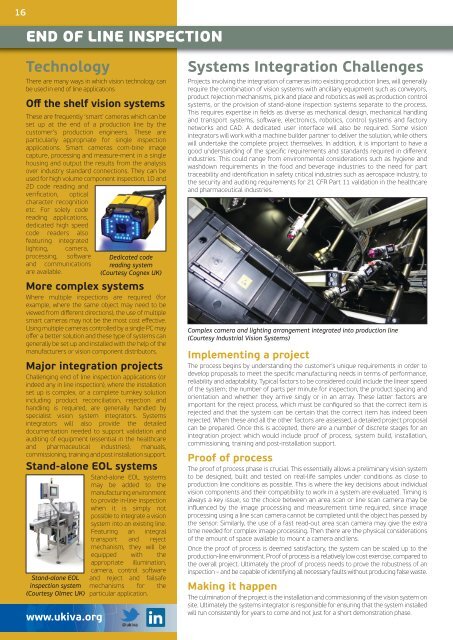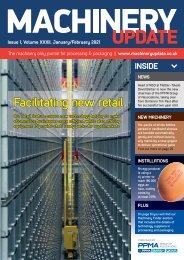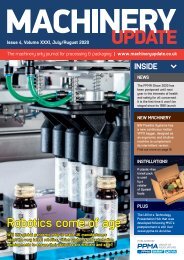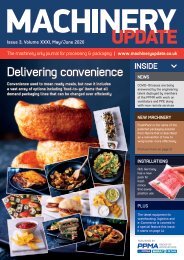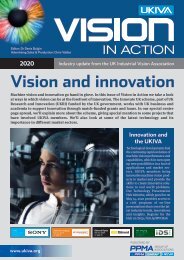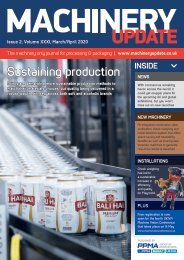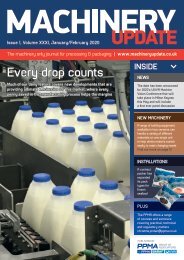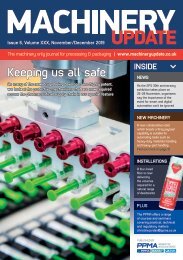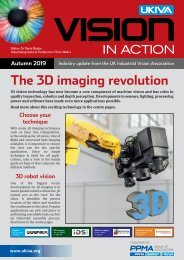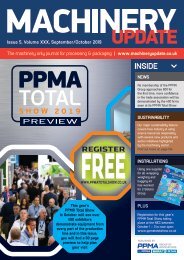Vision in Action - Autumn 2015
- No tags were found...
You also want an ePaper? Increase the reach of your titles
YUMPU automatically turns print PDFs into web optimized ePapers that Google loves.
16<br />
END OF LINE INSPECTION<br />
Technology<br />
There are many ways <strong>in</strong> which vision technology can<br />
be used <strong>in</strong> end of l<strong>in</strong>e applications<br />
off the shelf vision systems<br />
These are frequently ‘smart’ cameras which can be<br />
set up at the end of a production l<strong>in</strong>e by the<br />
customer’s production eng<strong>in</strong>eers. These are<br />
particularly appropriate for s<strong>in</strong>gle <strong>in</strong>spection<br />
applications. Smart cameras com-b<strong>in</strong>e image<br />
capture, process<strong>in</strong>g and measure-ment <strong>in</strong> a s<strong>in</strong>gle<br />
hous<strong>in</strong>g and output the results from the analysis<br />
over <strong>in</strong>dustry standard connections. They can be<br />
used for high volume component <strong>in</strong>spection, 1D and<br />
2D code read<strong>in</strong>g and<br />
verification, optical<br />
character recognition<br />
etc. For solely code<br />
read<strong>in</strong>g applications,<br />
dedicated high speed<br />
code readers also<br />
featur<strong>in</strong>g <strong>in</strong>tegrated<br />
light<strong>in</strong>g, camera,<br />
process<strong>in</strong>g, soſtware Dedicated code<br />
and communications read<strong>in</strong>g system<br />
are available.<br />
(Courtesy Cognex UK)<br />
More complex systems<br />
Where multiple <strong>in</strong>spections are required (for<br />
example, where the same object may need to be<br />
viewed from different directions), the use of multiple<br />
smart cameras may not be the most cost effective.<br />
Us<strong>in</strong>g multiple cameras controlled by a s<strong>in</strong>gle PC may<br />
offer a better solution and these type of systems can<br />
generally be set up and <strong>in</strong>stalled with the help of the<br />
manufacturers or vision component distributors.<br />
Major <strong>in</strong>tegration projects<br />
Challeng<strong>in</strong>g end of l<strong>in</strong>e <strong>in</strong>spection applications (or<br />
<strong>in</strong>deed any <strong>in</strong> l<strong>in</strong>e <strong>in</strong>spection), where the <strong>in</strong>stallation<br />
set up is complex, or a complete turnkey solution<br />
<strong>in</strong>clud<strong>in</strong>g product reconciliation, rejection and<br />
handl<strong>in</strong>g is required, are generally handled by<br />
specialist vision system <strong>in</strong>tegrators. Systems<br />
<strong>in</strong>tegrators will also provide the detailed<br />
documentation needed to support validation and<br />
audit<strong>in</strong>g of equipment (essential <strong>in</strong> the healthcare<br />
and pharmaceutical <strong>in</strong>dustries), manuals,<br />
commission<strong>in</strong>g, tra<strong>in</strong><strong>in</strong>g and post <strong>in</strong>stallation support.<br />
Stand-alone EoL systems<br />
Stand-alone EOL systems<br />
may be added to the<br />
manufactur<strong>in</strong>g environment<br />
to provide <strong>in</strong>-l<strong>in</strong>e <strong>in</strong>spection<br />
when it is simply not<br />
possible to <strong>in</strong>tegrate a vision<br />
system <strong>in</strong>to an exist<strong>in</strong>g l<strong>in</strong>e.<br />
Featur<strong>in</strong>g an <strong>in</strong>tegral<br />
transport and reject<br />
mechanism, they will be<br />
Stand-alone EOL<br />
<strong>in</strong>spection system<br />
(Courtesy Olmec UK)<br />
www.ukiva.org<br />
equipped with the<br />
appropriate illum<strong>in</strong>ation,<br />
camera, control soſtware<br />
and reject and failsafe<br />
mechanisms for the<br />
particular application.<br />
Systems Integration Challenges<br />
Projects <strong>in</strong>volv<strong>in</strong>g the <strong>in</strong>tegration of cameras <strong>in</strong>to exist<strong>in</strong>g production l<strong>in</strong>es, will generally<br />
require the comb<strong>in</strong>ation of vision systems with ancillary equipment such as conveyors,<br />
product rejection mechanisms, pick and place and robotics as well as production control<br />
systems, or the provision of stand-alone <strong>in</strong>spection systems separate to the process.<br />
This requires expertise <strong>in</strong> fields as diverse as mechanical design, mechanical handl<strong>in</strong>g<br />
and transport systems, soſtware, electronics, robotics, control systems and factory<br />
networks and CAD. A dedicated user <strong>in</strong>terface will also be required. Some vision<br />
<strong>in</strong>tegrators will work with a mach<strong>in</strong>e builder partner to deliver the solution, while others<br />
will undertake the complete project themselves. In addition, it is important to have a<br />
good understand<strong>in</strong>g of the specific requirements and standards required <strong>in</strong> different<br />
<strong>in</strong>dustries. This could range from environmental considerations such as hygiene and<br />
washdown requirements <strong>in</strong> the food and beverage <strong>in</strong>dustries to the need for part<br />
traceability and identification <strong>in</strong> safety critical <strong>in</strong>dustries such as aerospace <strong>in</strong>dustry, to<br />
the security and audit<strong>in</strong>g requirements for 21 CFR Part 11 validation <strong>in</strong> the healthcare<br />
and pharmaceutical <strong>in</strong>dustries.<br />
Complex camera and light<strong>in</strong>g arrangement <strong>in</strong>tegrated <strong>in</strong>to production l<strong>in</strong>e<br />
(Courtesy Industrial <strong>Vision</strong> Systems)<br />
Implement<strong>in</strong>g a project<br />
The process beg<strong>in</strong>s by understand<strong>in</strong>g the customer’s unique requirements <strong>in</strong> order to<br />
develop proposals to meet the specific manufactur<strong>in</strong>g needs <strong>in</strong> terms of performance,<br />
reliability and adaptability. Typical factors to be considered could <strong>in</strong>clude the l<strong>in</strong>ear speed<br />
of the system; the number of parts per m<strong>in</strong>ute for <strong>in</strong>spection, the product spac<strong>in</strong>g and<br />
orientation and whether they arrive s<strong>in</strong>gly or <strong>in</strong> an array. These latter factors are<br />
important for the reject process, which must be configured so that the correct item is<br />
rejected and that the system can be certa<strong>in</strong> that the correct item has <strong>in</strong>deed been<br />
rejected. When these and all the other factors are assessed, a detailed project proposal<br />
can be prepared. Once this is accepted, there are a number of discrete stages for an<br />
<strong>in</strong>tegration project which would <strong>in</strong>clude proof of process, system build, <strong>in</strong>stallation,<br />
commission<strong>in</strong>g, tra<strong>in</strong><strong>in</strong>g and post-<strong>in</strong>stallation support.<br />
Proof of process<br />
The proof of process phase is crucial. This essentially allows a prelim<strong>in</strong>ary vision system<br />
to be designed, built and tested on real-life samples under conditions as close to<br />
production l<strong>in</strong>e conditions as possible. This is where the key decisions about <strong>in</strong>dividual<br />
vision components and their compatibility to work <strong>in</strong> a system are evaluated. Tim<strong>in</strong>g is<br />
always a key issue, so the choice between an area scan or l<strong>in</strong>e scan camera may be<br />
<strong>in</strong>fluenced by the image process<strong>in</strong>g and measurement time required, s<strong>in</strong>ce image<br />
process<strong>in</strong>g us<strong>in</strong>g a l<strong>in</strong>e scan camera cannot be completed until the object has passed by<br />
the sensor. Similarly, the use of a fast read-out area scan camera may give the extra<br />
time needed for complex image process<strong>in</strong>g. Then there are the physical considerations<br />
of the amount of space available to mount a camera and lens.<br />
Once the proof of process is deemed satisfactory, the system can be scaled up to the<br />
production-l<strong>in</strong>e environment. Proof of process is a relatively low cost exercise, compared to<br />
the overall project. Ultimately the proof of process needs to prove the robustness of an<br />
<strong>in</strong>spection – and be capable of identify<strong>in</strong>g all necessary faults without produc<strong>in</strong>g false waste.<br />
Mak<strong>in</strong>g it happen<br />
The culm<strong>in</strong>ation of the project is the <strong>in</strong>stallation and commission<strong>in</strong>g of the vision system on<br />
site. Ultimately the systems <strong>in</strong>tegrator is responsible for ensur<strong>in</strong>g that the system <strong>in</strong>stalled<br />
will run consistently for years to come and not just for a short demonstration phase.


